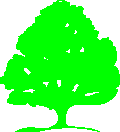
Coombe Wood — Diary and Recent Observations
Diary
This section comprises reports of recent visits to the wood, including observations on the wildlife and the land. If you would like to contribute to this diary, please do so through the Contacts page.
This diary is for 2017. If you would like to see the diary for 2016, here is the link. In the past, I have given detail of the first appearance of various plants, with illustrations as appropriate. This year, I shall not do so so much, unless there is something new to record.
This diary, like most internet diaries is presented with the most recent entries first.
August 6th Early Fungi
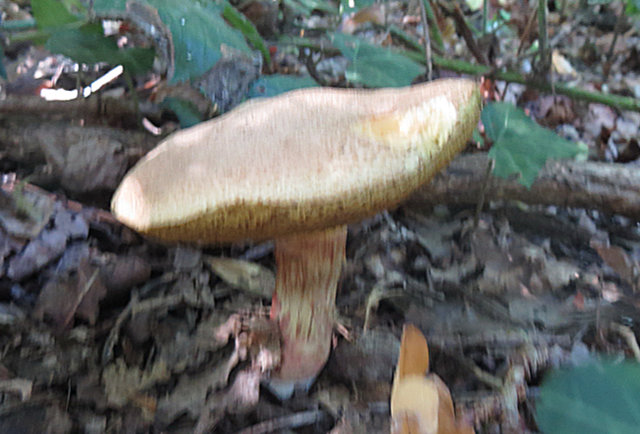
 I have not been in the woods for the last two months, having been on holiday and
coping with emergencies. Generally August is a quiet month. The only bird sounds were
Wood Pigeons and a Green Woodpecker. There was also scuffling on the woodland floor
from Grey Squirrels. I was surprised to see some early Fungi. There was a single
yellow Boletus (above) and a group of Charcoal Burners. There are so-called because they are supposed to crop up on areas that had been used
for charcoal burning. Both of these fungi were by the side of the path alongside the
stream.
I have not been in the woods for the last two months, having been on holiday and
coping with emergencies. Generally August is a quiet month. The only bird sounds were
Wood Pigeons and a Green Woodpecker. There was also scuffling on the woodland floor
from Grey Squirrels. I was surprised to see some early Fungi. There was a single
yellow Boletus (above) and a group of Charcoal Burners. There are so-called because they are supposed to crop up on areas that had been used
for charcoal burning. Both of these fungi were by the side of the path alongside the
stream. 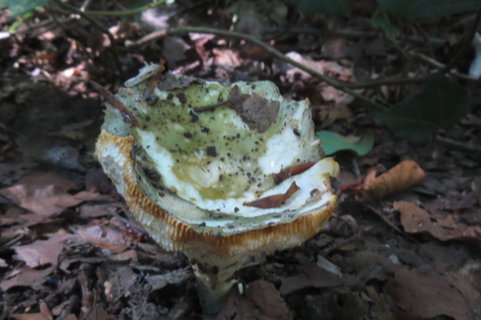
May 6th Bluebells and Birdsong
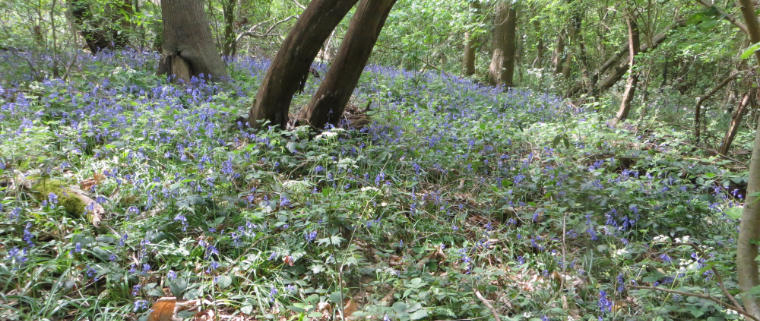
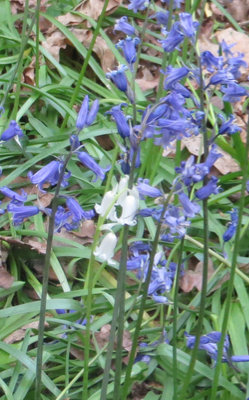 The weather has been dry of late, but with not much sun. However, spring was really in evidence. The Bluebells were probably just past their peak. There were vast swards in many parts of the wood, and just one or two white-flowered bluebells amongst them.
The weather has been dry of late, but with not much sun. However, spring was really in evidence. The Bluebells were probably just past their peak. There were vast swards in many parts of the wood, and just one or two white-flowered bluebells amongst them.
The Lesser Celandines were almost over, with just a few in flower. However, the Sanicle is now out, especially alonside the bridle paths. There was no sign of Wood Anemone flowers.
 The Spurge Laurel, which had flowered very early in the year, was now producing fruits, though these were still just elongate green berries.
The Spurge Laurel, which had flowered very early in the year, was now producing fruits, though these were still just elongate green berries.
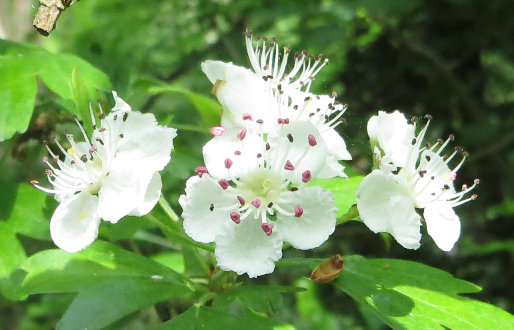 There are two species of Hawthorn in Coombe Wood. The Common Hawthorn is now well in flower, both in the wood and elsewhere. At the centre of each flower, you can see a single style – the pale yellow-green stalked blob. The leaves are deeply divided.
There are two species of Hawthorn in Coombe Wood. The Common Hawthorn is now well in flower, both in the wood and elsewhere. At the centre of each flower, you can see a single style – the pale yellow-green stalked blob. The leaves are deeply divided.
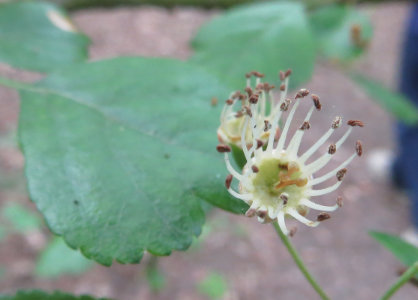 The Woodland Hawthorn flowers are now largely over. They can be distinguished from those of the Common Hawthorn by the presence of (usually) two styles. These styles persist after the petals fall, so they can still be identified. In the flower seen here, there are actually three styles, which is unusual. The leaves are not deeply divided.
The Woodland Hawthorn flowers are now largely over. They can be distinguished from those of the Common Hawthorn by the presence of (usually) two styles. These styles persist after the petals fall, so they can still be identified. In the flower seen here, there are actually three styles, which is unusual. The leaves are not deeply divided.
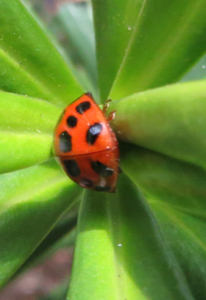
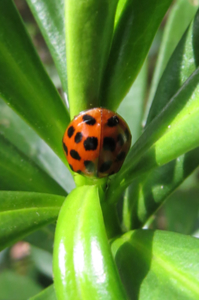 One new find in our visit was the Harlequin Ladybird. This is an Asian species that has recently colonized Britain and is competing with our native ladybirds. This one had its head down amongst the foliage of a Spurge Laurel, which meant that we could not see the distinctive markings on the thorax. However, we could see the brown legs (see the left picture.
One new find in our visit was the Harlequin Ladybird. This is an Asian species that has recently colonized Britain and is competing with our native ladybirds. This one had its head down amongst the foliage of a Spurge Laurel, which meant that we could not see the distinctive markings on the thorax. However, we could see the brown legs (see the left picture.
The birds were in full song. We did not see many, just Jays and Wood Pigeons. However we heard Robin, Blackbird, Wren and others that we could not identify.
March 27th 2017 – Spring is showing
The weather has been dry recently with a fair amount of sunshine, although there was some rain in the previous week. Most of the trees were showing new leaves, although the Oak was rather behind the rest. The ground flora was in full leaf and some, but not all were in flower. The most obvious flowers were the Wood Anemones:
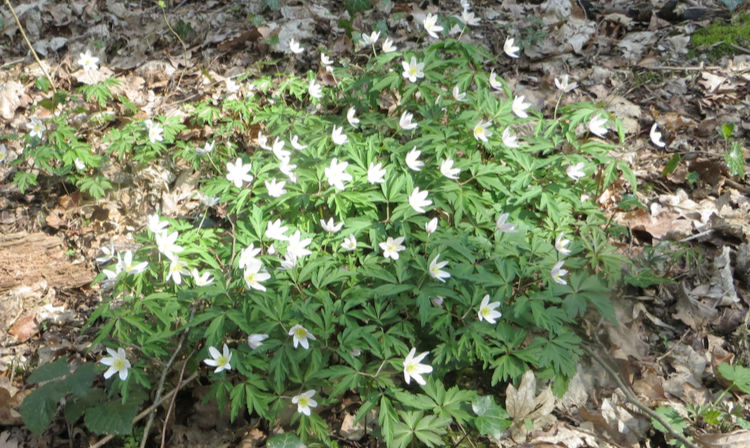
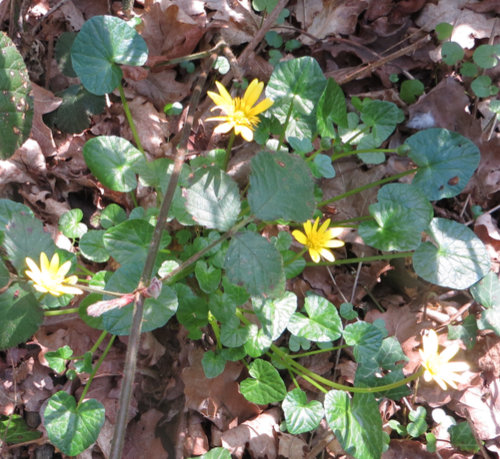 The Lesser Celandine, along with the Wood Anamone, is the other main early harbinger of Spring. They are particularly common in the damper patches, near the streams. This was an unusually large one, growing amongst the brambles.
The Lesser Celandine, along with the Wood Anamone, is the other main early harbinger of Spring. They are particularly common in the damper patches, near the streams. This was an unusually large one, growing amongst the brambles.
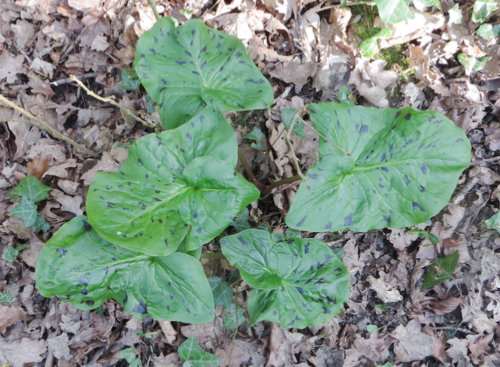 The plants still in leaf but not yet in flower included Bluebells, Cow Parsley, Enchanter’s Nightshade, Town Hall Clock and Wild Arum. The scientific name of this is Arum maculatum (meaning spotted) which this picture shows clearly.
The plants still in leaf but not yet in flower included Bluebells, Cow Parsley, Enchanter’s Nightshade, Town Hall Clock and Wild Arum. The scientific name of this is Arum maculatum (meaning spotted) which this picture shows clearly.
There were still some Fungi in evidence, mostly those growing on trees.
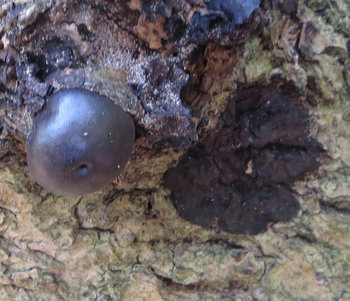
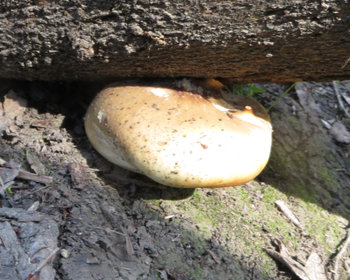
King Alfred’s Cakes (left) are a very persistent fungus, lasting for many years. The black smudge is where one has been knocked off. This one was growing on a large dead tree that had fallen over the path by the stream. Polypore fungi such as the one on the right can still last a year or so. However, this was growing on a fallen log lying by the side stream, squashed between the log and the ground!
January 2nd 2017 – some Fungi are still around
The weather was cold but dry after some rail in the previous week. Rather surprisingly there were still some fungi to be seen. Bracket fungi, such as the Turkey Tail (below left) growing on fallen logs, are regularly found throughout the year. There were other fungi growing on dead wood, including the Common Bonnet (below right).
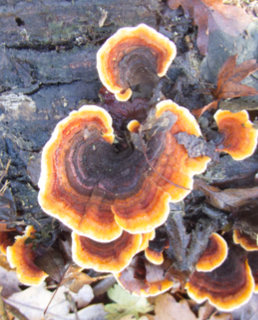
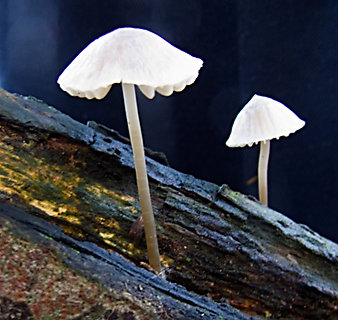
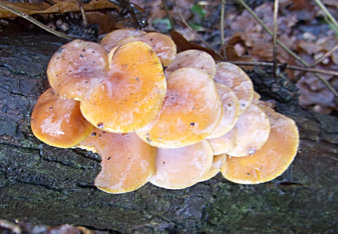
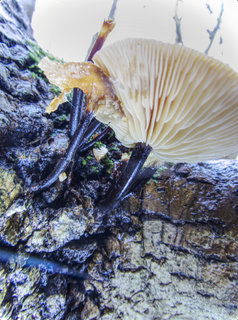 There was another, as yet unidentified species on various logs. I think that these are both the same species.
There was another, as yet unidentified species on various logs. I think that these are both the same species.
Other fungi were growing on the ground. Again, I have not yet been able to identify either of these.
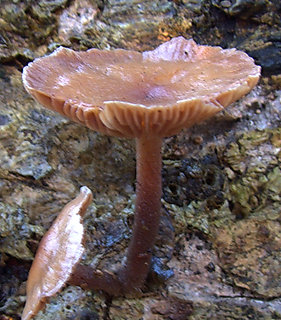
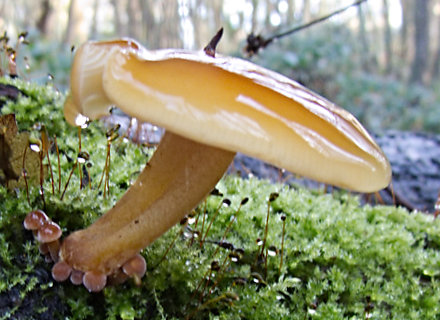
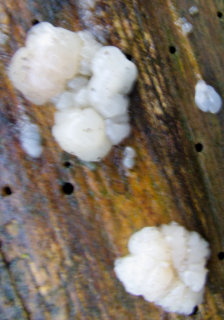 In addition to these fungi, I found a slime-mould Reticularia, also growing on a dead log. These are organisms unrelated to neither plants, animals nor fungi. They look like blobs of jelly, about 2–3cm across.
In addition to these fungi, I found a slime-mould Reticularia, also growing on a dead log. These are organisms unrelated to neither plants, animals nor fungi. They look like blobs of jelly, about 2–3cm across.
February 3rd – Birds from Gwyn Jordan
Gwyn took his camera to the wood and was able to get some nice pictures of four of our woodland birds. These are, in order: Blue Tit, Long-tailed Tit, Robin and Song Thrush.
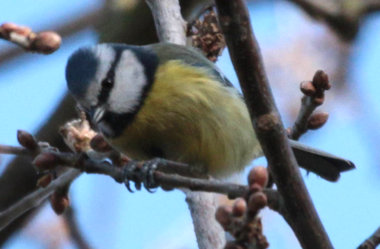
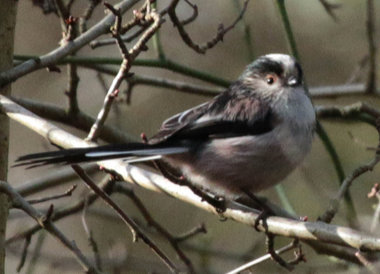
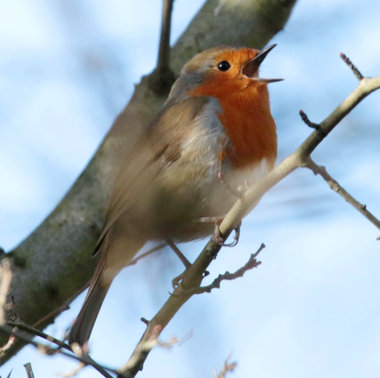
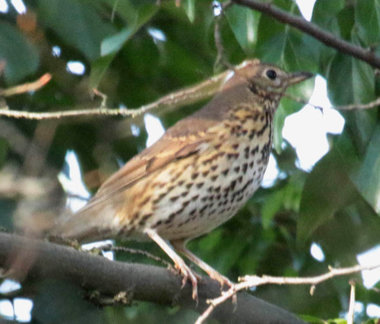
February 23rd – very little happening!
By the end of February, there was no sign of the earlier fungi and the birds were also remarkable quiet. There was little signs of the trees and shrub buds beginning to sprout, just those of the Blackthorn or Sloe. The foliage of the herbs on the woodland floor were in evidence though: Cow Parsley, Sanicle and Dog Violet.
